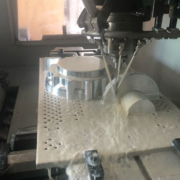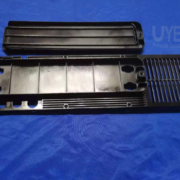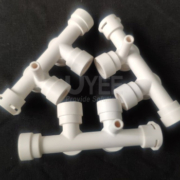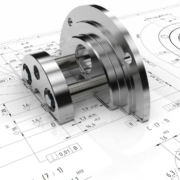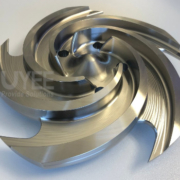Which CNC Coolant Should You Pick When Milling Titanium?
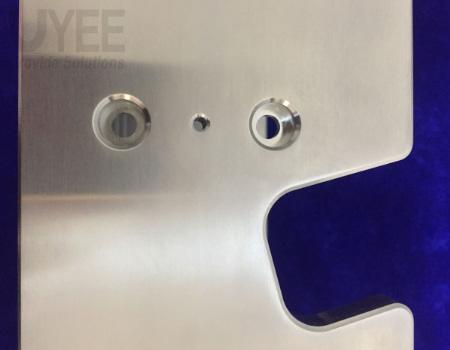
Coolants are an essential aspect of the titanium machining process. The proper coolant may prolong tool life, shorten machining times, and save waste. Anyone looking for the best coolant should keep the three major functions of a good coolant in mind. These are as follows: lubrication, cooling, and chip removal. If you can discover a coolant that can do all three of these jobs, your productivity will skyrocket.
Titanium Concerns
Workholding
Although titanium has better material qualities than steel, it also behaves flexibly and is not always as rigid as other metals. It necessitates a firm grasp on CNC titanium parts and the most rigid machine setup feasible.
Other variables to be considered include avoiding interrupted cuts and keeping the tool moving when the workpiece contacts. Dwelling in a drilled hole or stopping a tool next to a profiled wall causes the tool to rub, causing extra heat, work-hardening the material, and premature tool wear.
Heat Generation
Heat is a dangerous foe, and heat generation must be considered while determining speeds and feeds. While commercially pure titanium is softer and gummier than most alloys, alloying elements often increase titanium hardness. It raises concerns about generated heat and tool wear. Maintaining a greater chip load and minimizing excessive rubbing improves tool performance in tougher Milling titanium alloys and reduces work hardening.
When compared to higher speed choices, choosing a lower RPM mixed with a bigger chip load can yield a substantial reduction in temperature. Because of its limited conduction qualities, keeping temperatures low puts less strain on the tool and reduces wear. When machining Titanium precision parts, using a high-pressure coolant is also an excellent way to limit heat generation.
Galling and Built-Up Edge
The second challenge is that titanium has a strong inclination to stick to a cutting tool, resulting in a built-up edge. It is a complex problem that it can mitigate by directing huge volumes of high-pressure coolant directly at the cutting surface. The purpose is to remove chips as quickly as possible to avoid chip re-cutting and keep the flutes clean and clear. Finally, annoying is a major hazard in economically pure titanium grades due to its “gummy” character. We can solve the previously indicated solutions by providing continuous feed at all workpiece contact and enough high-pressure coolant.
Types of Coolant
Liquids, pastes or gels, CO2, aerosols, air, or other gasses are the five types of coolants commonly used in machining. All of them can be successful, but each has drawbacks, so the type of coolant you use will be determined by the sort of machining you do.
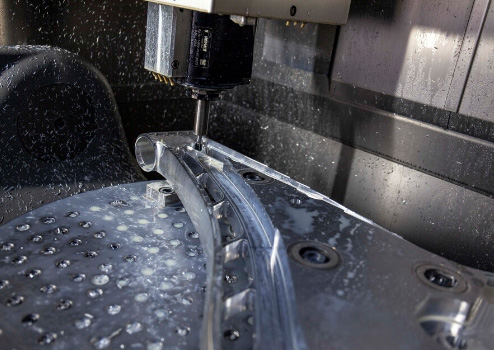
Liquid Coolant
Mineral, semi-synthetic, and synthetic liquid coolants are the three types of liquid coolants. Mineral lubricants are derived from petroleum. These provide excellent lubrication but lack the cooling power of their synthetic and semi-synthetic counterparts. Depending on the application, high flow or high-pressure spray is required for proper chip removal when utilizing this type of coolant.Oil and water are combined in semi-synthetic lubricants. Small amounts of oil are often suspended in large amounts of water using an emulsifying agent such as detergent. Because water is excellent at dealing with heat, and oil offers lubrication and corrosion resistance, this is frequently employed in CNC machining. Because of high pressure or high flow rates, this type of coolant is also great for chip removal.Synthetic lubricants are often water-based artificial coolants with a variety of properties. These coolants, like semi-synthetic, provide cooling and lubrication. Depending on how the coolant is used, they can also assist chip removal.
Paste or Gel Coolant
We can do some methods of metal cutting, drilling, or tapping with paste or gel coolants. They are not, however, suited for industrial applications and do not aid in removing chips.
Aerosol Coolant
Traditional aerosol coolants were woefully inefficient. They were hazardous to employees, difficult to direct, and generally sprayed coolant everywhere except where needed. Aerosol coolant can now be precisely guided to the cutting surface while going straight through the tooling using MQL (minimum quantity lubrication). The only problem with aerosol coolants is heat dissipation. MQL provides ample lubrication, which aids in heat reduction; however, heat can remain in the tooling because relatively little fluid is utilized.
CO2 Coolant
C02 coolant operates through phase shifts. Allowing liquid CO2 to expand lowers its temperature and converts the liquid to tiny solid crystals. Through the spindle or a sprayer, these crystals are driven into the cutting zone. It drives the chips out and creates a super cooling stream, which minimizes heat. Unfortunately, CO2 does not give lubrication, which can interfere with cutting.
Air or Other Gas Coolants
Air, either ambient or compressed, was traditionally employed as a cooling. A forceful stream of air eliminates chips while also providing some cooling. Nitrogen is the gas of choice in modern milling. Liquid nitrogen can be sprayed on the tool or chilled to the extent that it can absorb the excess heat created during processing in combination with MQL. It does not provide lubrication, but it can considerably increase tool life.
Coolant Delivery Methods
In addition to the various types of coolant, there are many techniques for providing coolant to the tools. In recent years, these have changed dramatically to become far more effective. For example, coolant may now be administered rapidly and precisely to accommodate even the fastest speeds and feed rates.
Flooding
Coolant flooding has been and is a common method in many processing applications. In this method, coolant is delivered using high-volume nozzles utilizing low pressure. The benefit is that adequate refrigeration and removal of chips are available. The disadvantage is that a large amount of coolant is required to complete the task.
Spraying
Spraying coolant differs from flooding in that it is frequently performed under high pressure. It implies that it is only applied to the specific region that is required. Spray coolant has the advantage of requiring less coolant and removing chips more effectively. The disadvantage is that coolant continues to be wasted when it bounces off the tools and work area.
Misting
Misting has typically been an imprecise spray of aerosol coolants delivered through nozzles. It is now commonly utilized in a through-tool coolant system. It is now quite efficient and may be used with MQL systems. Its only disadvantage is that it does not give the same level of heat dissipation as floods or other high-flow cooling systems.
Through-Tool Coolant
This technique wastes nearly no coolant using liquid, aerosol, or gas coolants provided through the tooling. Depending on the type of coolant, it can provide lubrication as well as heat resistance.
Coolant Recovery
After you’ve decided on your coolant distribution system and coolant type, you should consider your coolant recovery system. High flow systems, such as flooding and spraying, typically require a sump to recover and reuse coolant. The nitrogen or CO2 in gas systems is dispersed into the atmosphere. Because they use such little volumes of coolant, through-tool and misting coolant delivery systems do not always require a coolant recovery system.
Keep in mind that the proper type and use of coolant are critical for successful machining. Without it, tool life and overall material finish, as well as productivity, will suffer dramatically.

